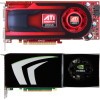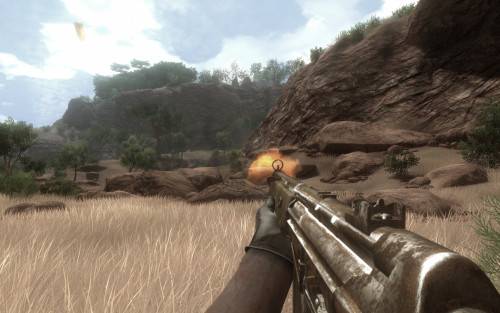- Qualcomm Launches Snapdragon 4 Gen 2 Mobile Platform
- AMD Launches Ryzen PRO 7000 Series Mobile & Desktop Platform
- Intel Launches Sleek Single-Slot Arc Pro A60 Workstation Graphics Card
- NVIDIA Announces Latest Ada Lovelace Additions: GeForce RTX 4060 Ti & RTX 4060
- Maxon Redshift With AMD Radeon GPU Rendering Support Now Available
ATI Radeon HD 4890 & NVIDIA GeForce GTX 275

It’s not often we get to take two brand-new GPUs and pit them against each other in one launch article, but that’s what we’re doing with ATI’s HD 4890 and NVIDIA’s GTX 275. Both cards are priced at $249, and both also happen to offer great performance and insane overclocking-ability. So coupled with those and other factors, who comes out on top?
Page 7 – Far Cry 2
Sequels are common, and three of our six games used here prove it. But what’s different with Far Cry 2, though, is that while the other sequels here don’t throw you for a loop when you first load it up and generally give you what you’d expect to see, this game does the absolute opposite. We knew for months that Far Cry 2 wasn’t going to be a direct continuation of the original, but for the most part, this game could have gone by any other name and no one would even make a connection. Luckily for Ubisoft, though, the game can still be great fun.
Like the original, this game is a first-person shooter that offers open-ended gameplay, similar to S.T.A.L.K.E.R. You’ll be able to roam the huge map (50km^2) of a central African state which will mostly be traversed by vehicle, as walking even 2% in any direction gets very tedious after a while. This game is a perfect GPU benchmark simply because the graphics are better than the average, with huge draw distances, realistic nature and even a slew of animals to pass by (and kill if you are evil enough).
Our run through takes place in the Shwasana region, and consists of leaving a small hut and walking towards four people prepared to kill me for no apparent reason (except that this is a game). After the opponents are eliminated, a walk along the dirt road continues for another twenty seconds until we reach a small hut with supplies.



We’re running into a recurring theme here, but ATI’s HD 4890 comes closer to the GTX 275 in this title than the other games we’ve tested so far, and actually passes it in our 2560×1600 test. Neither card has the oomph required to deliver fully enjoyable gameplay at that top resolution though, so let’s get rid of AA and see how things stand.
|
Graphics Card
|
Best Playable
|
Avg. FPS
|
|
NVIDIA GTX 285 1GB x 2
|
2560×1600 – Max Detail, 8xAA
|
46.502 FPS
|
|
NVIDIA GTX 295 1792MB x 2
|
2560×1600 – Max Detail, 4xAA
|
88.608 FPS
|
|
Zotac GTX 295 1792MB
|
2560×1600 – Max Detail, 4xAA
|
55.951 FPS
|
|
Palit HD 4870 X2 2GB
|
2560×1600 – Max Detail, 4xAA
|
43.600 FPS
|
|
NVIDIA GTX 285 1GB
|
2560×1600 – Max Detail, 4xAA
|
37.785 FPS
|
|
Sapphire HD 4890 1GB
|
2560×1600 – Max Detail, 0xAA
|
48.568 FPS
|
|
NVIDIA GTX 275 896MB
|
2560×1600 – Max Detail, 0xAA
|
47.509 FPS
|
|
Palit GTX 280 1GB
|
2560×1600 – Max Detail, 0xAA
|
43.460 FPS
|
|
Diamond HD 4870 1GB
|
2560×1600 – Max Detail, 0xAA
|
41.777 FPS
|
|
XFX GTX 260/216 896MB
|
2560×1600 – Max Detail, 0xAA
|
38.527 FPS
|
|
ASUS GeForce 9800 GTX+ 512MB
|
2560×1600 – Max Detail, 0xAA
|
34.735 FPS
|
|
NVIDIA GeForce GTS 250 1GB
|
2560×1600 – Max Detail, 0xAA
|
31.521 FPS
|
|
Sapphire HD 4830 512MB
|
1920×1200 – Max Detail, 0xAA
|
38.323 FPS
|
|
Sapphire HD 4670 512MB
|
1920×1200 – Max Detail, 0xAA
|
28.819 FPS
|
With anti-aliasing turned off, things improve a great deal for both cards. Whereas with AA, things were a bit sluggish, removing it bursts new life into the game. Once again, ATI’s card managed to creep up past NVIDIA’s in this test.
Support our efforts! With ad revenue at an all-time low for written websites, we're relying more than ever on reader support to help us continue putting so much effort into this type of content. You can support us by becoming a Patron, or by using our Amazon shopping affiliate links listed through our articles. Thanks for your support!






